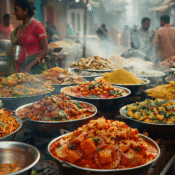
Diwali 2024: A Comprehensive Guide to India’s Grand Festival of Lights
We would like to describe the ideal Diwali celebration in India as follows: candlelight, clay lamps, homes filled with the pleasant smell of delicious sweets, the warmth of relatives and friends, and the chill of the impending winter season. The largest holiday in India is called Diwali, or the “festival of lights,” and it is mostly observed by Sikhs, Jains, and Hindus worldwide. In addition to celebrating the triumph of virtue over evil, it offers people a chance to move on, forgive one another, and have fun.
The celebration of an auspicious event like Diwali, or Deepavali as some name it, is the epitome of cultural exuberance. It presents itself as a time of year when everyone remembers their memories of home, family, friends, and the many other things that this religious and socially significant celebration unites people around. More than just folklore is celebrated; it’s also about reliving childhood moments, spending time with relatives after a long absence, and watching fireworks light up the night sky.
Importance Of Diwali Celebration In India
Diwali, a five-day celebration, commemorates the return of Lord Rama, Sita, and Laxmana following a protracted 14-year exile. Diwali, which translates literally from Sanskrit as “a row of lights,” was initially observed by the inhabitants of Ayodhya to celebrate the arrival of their King, Rama, following his victory against Ravana. It’s also thought by some Indians to be a celebration of Lord Vishnu and Lakshmi’s marriage.
On the day of Diwali, most regions celebrate Lord Ganesha, the god of wisdom and auspiciousness. In Jainism, Diwali commemorates the anniversary of Nirvana, or the soul’s release of Mahavira. Diwali is observed in West Bengal to honour goddess Kali, the goddess of Shakti, which signifies strength and energy.
Reasons For Diwali Celebration In India

Diwali is commemorated for more reasons than only Lord Ram’s return to Ayodhya following his defeat over Ravana. Here are some further explanations for why Diwali is celebrated:
- The three realms invaded by Narakaasur were vanquished by Lord Krishna the day before Diwali. Narakaasur was murdered by Krishna. Naraka Chaturdasi is observed on the day after Diwali.
- The birthday of Goddess Laxmi: Known as the “Goddess of Wealth,” Goddess Laxmi is one of the most important Hindu goddesses. Today. For prosperity and money, people worship the goddess Laxmi.
- The Return of the Pandavas: According to the Mahabharata, on the day of Kartik Amavasya, or Diwali, the Pandavas overcame the Kauravas and were allowed to return after a 12-year exile.
How Is Diwali Celebrated In Different Parts Of India
Deepavali 2023 is on November 15th. Traditionally, Diwali is celebrated on the third day of the festival. Similar to other well-known Indian holidays, Diwali is celebrated nationwide with great fervour and grandeur, bringing the nation together. On the eve of Diwali, people typically exchange gifts, don new attire, and purchase gold or silver jewellery if they can.
1. North India

Deepavali is a festival celebrated in (Himachal Pradesh, Uttarakhand, Rajasthan, Srinagar, Delhi, and Punjab) with lights, fireworks, and sweets. On this day, Hindu households also worship the goddess Lakshmi and the god Ganesha. You shouldn’t miss the Diwali Mela in Delhi if you’re in the nation’s capital since it offers the best Diwali celebration in India, along with decorations and food items to purchase. On Diwali, Uttar Pradesh is regarded as one of the top destinations!
2. East India

Diwali celebrations in East India are mostly centred around the night of ancestors, with earthen oil lamps lighted on poles in Odisha to guide the souls of deceased loved ones to heaven (West Bengal, Bihar, Jharkhand, Assam, and Odisha). On the eve of the Diwali festival, people in West Bengal and Assam worship Goddess Kali and pay prayers to their ancestors. In the evenings, people in Bihar and Jharkhand do Lakshmi pooja, and women decorate their homes and temples with rangolis. Visit any of these locations to experience Diwali in India.
3. West India

(Maharashtra and Gujarat), rangoli is a crucial component of their Diwali décor. On the night of Diwali, Maharashtrians perform Lakshmi pooja in their homes and host a feast known as “Faral” for families and friends, where sweets like karanji and ladoo and snacks like chakli and sev are served. Gujaratis, on the other hand, draw the footprints of goddess Laxmi on the threshold of their homes and light their homes with candles, rice lights, and diyas.
4. South India

(Andhra Pradesh, Karnataka, and Tamil Nadu): Kannadigas build forts out of cow dung in their homes and take oil baths, while Andhrites and Tamilians celebrate the victory of Lord Krishna and his wife Satyambha against the wicked King Narkasura.
Diwali Celebration Around The World
Indians all throughout the world celebrate Diwali as a time of happiness, festivity, and family time. Although the festival is widely observed across the nation, it is also observed in other nations with sizable Hindu populations, such as Africa, Australia, Japan, Fiji, Guyana, Singapore, Myanmar, Indonesia, Britain, Malaysia, Thailand, and Mauritius. Thus, if you’d want to observe the holiday in a different manner, take your loved ones to one of these foreign locations for Diwali.
Food Delights Of Diwali Across India
When we think of Diwali cuisine, one thing that immediately comes to mind is sweets—lots of them. In addition to enhancing the décor of your home for Diwali, these mouthwatering delicacies bring flavour and colour to the celebration. Every state in India has a unique method of enhancing the flavour of Diwali, ranging from the mouthwateringly rich barfis to the spicy mathris. Thus, finish off your Diwali preparations while indulging in these exquisite treats:
1. Gulab Jamun

This brownish-red confection, which is made with flour, clarified butter, and powdered or condensed milk, is a staple in every family during the festival and is an essential part of the Diwali celebration in North India. Your cravings won’t be met by just one dumpling, unless, of course, you have an extreme sweet taste.
2. Samosa

Nobody needs to introduce samosas. Samosa is always present, whether it is for a festival or the Indian Diwali celebration. You’ve never had a more delicious filled pastry than this one, most likely. There are numerous methods to prepare and fill it, ranging from paneer and potato peas to chicken and meat.
3. Anarsa

Anarsa, a traditional sweet food from Maharashtra, is often consumed during the Diwali holiday in both Maharashtra and Bihar. The blend of jaggery, rice, poppy seeds, and ghee is just right. Due to its high iron and calcium content, this sweet dish is not only delicious but also healthful.
4. Cholafali

Cholafali, a spicy and fluffy Gujarati snack made on Diwali, is made using a combination of flours, particularly Chana Dal flour, and traditional Gujarati spices. You can experiment with nearly anything. Indians enjoy adding it to their food to give it more flavour and crunch.
5. Murukku

In South India, particularly in Kerala and Tamil Nadu, a Diwali celebration would not be complete without making murukku. It’s a spicy, deep-fried snack prepared of rice flour and lentils. It originated in Tamil Nadu and is especially well-liked in the Trichy district’s Manapparai.
6. Ukkarai

Ukkarai, a unique Diwali treat, is mostly made by Tamil Brahmins from Chettinad. Jaggery and gram flour are used in its preparation. When you celebrate Diwali in India, make sure to sample this delicious dish
All Categories
- Adventure
- Australia
- City Tours
- Customized Holidays
- Domestic
- Dubai
- Europe
- Forex
- Group Holidays
- Honeymoon
- India
- Indonesia
- Informative
- International
- Korea
- Leisure Holidays
- Life Style
- Mauritius
- philippines
- Pilgrimage
- places to visit
- Remittance
- Singapore
- Thailand
- Things To Do
- Turkey
- Uncategorized
- Valentine
- Varanasi
- Vietnam
- VISA
- Weekend Getaways
- Wild Camping
Recent Posts
Budget Travel Tips: How to Travel More by Spending Less!!
Nature Therapy: Destinations That Heal Your Mind and Soul
Food Trails of the World: Destinations Every Food Lover Must Experience!!
Tags






